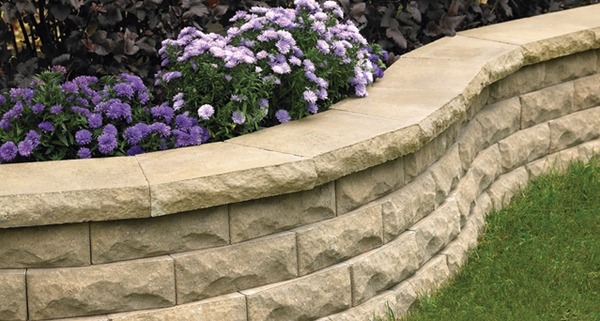

Form the fabric into a large C shape, with the open mouth of the C facing downhill. If you live where it doesn’t freeze and your soil drains well, you may be able to just scrape away topsoil to form a base for nonmortared walls.īefore adding gravel, lay down enough landscape fabric to contain the new gravel. Nonmortared walls should be built on a gravel-filled trench dug below frost line. Mortared or concrete walls in heavy-frost areas require footings dug below the frost line. The depth you need to excavate depends on frost depth as well as the wall and soil type. How deep should the footing be for a retaining wall? That’s why all strong retaining walls begin with landscape fabric, backfill, and 4-inch perforated drainpipe. Poor drainage resulting in saturated soil and frost heaving is the main cause of failure.
#Landscape blocks for retaining walls how to
Timber walls are only moderately challenging to build by yourself up to 4 feet high | Photo by Carolyn Bates How to Build a Retaining Wall
#Landscape blocks for retaining walls for free
But shop around some landscape firms do the design work for free if they do the installation. Add 10 percent or so if you hire a landscape architect or engineer. Preparing a troublesome site-one that includes clay soil or a natural spring, for example-can raise costs substantially. If you have your retaining wall built, figure about $15 per square face foot for a timber wall, $20 for an interlocking-block system or poured concrete, and $25 for a natural-stone wall. If you need a taller wall, consider step-terracing the lot with two walls half as big, or call in a landscape architect or structural engineer for the design work (have the architect or engineer inspect the site thoroughly) and experienced builders for the installation. With forces like these in play, you should limit your retaining wall efforts to walls under 4 feet tall (3 feet for mortarless stone). Double the wall height to 8 feet, and you would need a wall that’s eight times stronger to do the same job.

A 4-foot-high, 15-foot-long wall could be holding back as much as 20 tons of saturated soil. That’s because most residential retaining walls have poor drainage, and many aren’t built to handle the hillside they’re supposed to hold back.Įven small retaining walls have to contain enormous loads. Common Problems: Drainage, Weight of SoilĪlthough retaining walls are simple structures, a casual check around your neighborhood will reveal lots of existing walls that are bulging, cracked, or leaning. We also review the four most common types below: timber, interlocking blocks, stacked stone, brick or block, and concrete. If your property needs a retaining wall, or if the one you have is failing, follow our guide on how to build a retaining wall or hire a pro.

These handsome barriers also make inviting spots to sit, and can increase usable yard space by terracing sloped properties, something that is increasingly important as flat home sites become ever more scarce in many regions.Īlong with sloped landscapes where water runoff causes hillside erosion, ideal locations for a retaining wall system include spots downhill from soil fault lines and where the downhill side of a foundation is losing supporting soil or its uphill side is under pressure from sliding soil. They restrain tons of saturated soil that would otherwise slump and slide away from a foundation or damage the surrounding landscape. But in fact, they’re carefully engineered systems that wage an ongoing battle with gravity. Sure, retaining walls look like simple stacked stone, block, or timber.


 0 kommentar(er)
0 kommentar(er)
